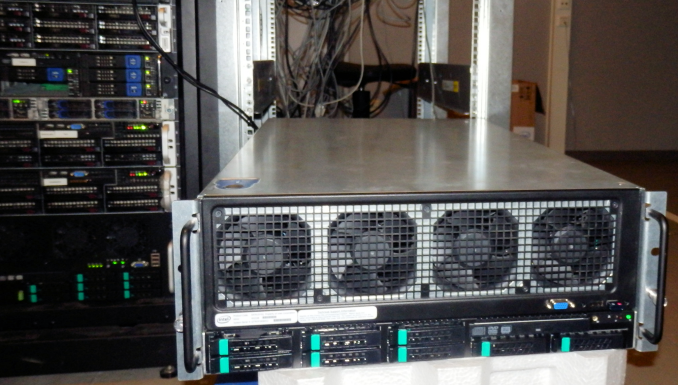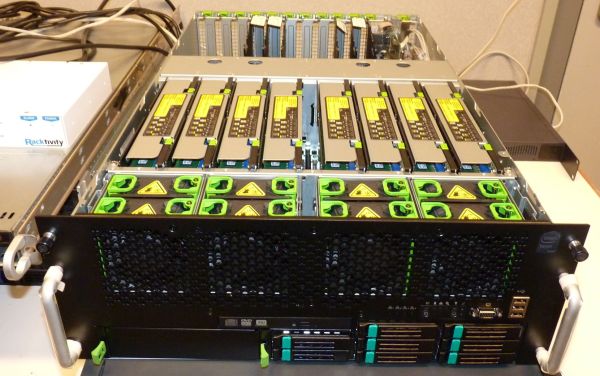The Intel Xeon E7-8800 v3 Review: The POWER8 Killer?
by Johan De Gelas on May 8, 2015 8:00 AM EST- Posted in
- CPUs
- IT Computing
- Intel
- Xeon
- Haswell
- Enterprise
- server
- Enterprise CPUs
- POWER
- POWER8
Benchmark Configuration
As far as reliability is concerned, while we little reason to doubt that the quad Xeon OEM systems out there are the pinnacle of reliability, our initial experience with Xeon E7 v3 has not been as rosy. Our updated and upgraded Quad Xeon Brickland system was only finally stable after many firmware updates, with its issues sorted out just a few hours before the launch of the Xeon E7 v3. Unfortunately this means our time testing the stable Xeon E7 v3 was a bit more limited than we would have liked.
Meanwhile to make the comparison more interesting, we decided to include both the Quad Xeon "Westmere-EX" as well as the "Nehalem-EX". Remember these heavy duty, high RAS servers continue to be used for much longer in the data center than their dual socket counterparts, 5 years or more are no exception. Of course, the comparison would not be complete without the latest dual Xeon 2699 v3 server.
All testing has been done on 64 bit Ubuntu Linux 14.04 (kernel 3.13.0-51, gcc version 4.8.2).
Intel S4TR1SY3Q "Brickland" IVT-EX 4U-server
The latest and greatest from Intel consists of the following components:
| CPU | 4x Xeon E7-8890v3 2.5 GHz 18c, 45 MB L3, 165W TDP or 4x Xeon E7-4890 v2 (D1 stepping) 2.8GHz 15 cores, 37.5MB L3, 155W TDP |
| RAM | 256 GB, 32x 8 GB Micron DDR-4-2100 at 1600MHz or 256 GB, 32x8GB Samsung 8GB DDR3 M393B1K70DH0-YK0 at 1333MHz |
| Motherboard | Intel CRB Baseboard "Thunder Ridge" |
| Chipset | Intel C602J |
| PSU | 2x1200W (2+0) |
Total amount of DIMM slots is 96. When using 64GB LRDIMMs, this server can offer up to 6TB of RAM.
If only two cores are active, the 8890 can boost the clockspeed to 3.3 GHz (AVX code: 3.2 GHz). The 4890v2 reaches 3.4 GHz in that situation. Even with all cores active, 2.9 GHz is possible (AVX code: 2.6 GHz).
Intel Quanta QSCC-4R Benchmark Configuration
The previous quad Xeon E7 server, as reviewed here.
| CPU | 4x Xeon X7560 at 2.26GHz, or 4x Xeon E7-4870 at 2.4GHz |
| RAM | 16x8GB Samsung 8GB DDR3 M393B1K70DH0-YK0 at 1066MHz |
| Motherboard | QCI QSSC-S4R 31S4RMB00B0 |
| Chipset | Intel 7500 |
| BIOS version | QSSC-S4R.QCI.01.00.S012,031420111618 |
| PSU | 4x850W Delta DPS-850FB A S3F E62433-004 850W |
The server can accept up to 64 32GB Load Reduced DIMMs (LR-DIMMs) or 2TB.
Intel's Xeon E5 Server – "Wildcat Pass" (2U Chassis)
Finally, we have our Xeon E5 v3 server:
| CPU | Two Intel Xeon processor E5-2699 v3 (2.3GHz, 18c, 45MB L3, 145W) |
| RAM | 128GB (8x16GB) Samsung M393A2G40DB0 (RDIMM) |
| Internal Disks | 2x Intel MLC SSD710 200GB |
| Motherboard | Intel Server Board Wilcat pass |
| Chipset | Intel Wellsburg B0 |
| BIOS version | August the 9th, 2014 |
| PSU | Delta Electronics 750W DPS-750XB A (80+ Platinum) |
Every server was outfitted with two 200 GB S3700 SSDs.












146 Comments
View All Comments
TheSocket - Friday, May 8, 2015 - link
They sure wouldn't lose the x86-64 license since they own it and Intel is licensing it from AMD.melgross - Saturday, May 9, 2015 - link
But without the license from Intel, it is worthless. There's also the question of how that works. I believe that Intel doesn't need to license back the 64 bit extensions.Kevin G - Monday, May 11, 2015 - link
This one of the reasons why it would be in Intelsat best interest to let AMD be bought out with the 32 bit license intact. The 64 bit license/patents going to a third party that doesn't want to share would be a dooms day scenario for Intel. Legally it wouldn't affect anything currently on the market but it'd throw Intel's future roadmap into the trash.Death666Angel - Saturday, May 9, 2015 - link
Pretty sure some regulatory bodies would step in if Intel were the only x86 game in town. And x86-64 is AMD property.JumpingJack - Saturday, May 9, 2015 - link
Any patents on x86 are long expired, AMD only owns the IP related to the extension of the x86 not the instruction set.patrickjp93 - Monday, May 11, 2015 - link
Not true. The U.S. government has them locked up under special military-based protections. Absolutely no one can make and sell x86 without Intel's and the DOD's permission.Kevin G - Monday, May 11, 2015 - link
Got a source for that?I know that DoD did some validation on x86 many years ago. (The Pentium core used by Larrabee had the DoD changes incorporated.)
haplo602 - Friday, May 8, 2015 - link
hmm ... where's the RAS feature comparison/test ? did I miss it in the article ?TeXWiller - Friday, May 8, 2015 - link
In the E7v3 vs POWER comparison table, there should be 32 PCIe lanes instead 40 in the Xeon column.TeXWiller - Friday, May 8, 2015 - link
Additionally, it is the L3 in POWER8 that runs half of the core speed. L2 runs at the core speed.